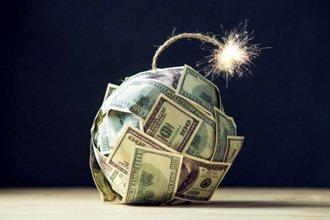Right now, investors are spending hours looking at charts and trying to time the bottom.
I'm warning you right now: Stop trying.
The market's negative momentum is the highest it has been since December 2018. And there is no justification for a bounce back with sentiment where it sits.
The Fed has already cut interest rates by 50 basis points. The Dow plunged several hundred points after the announcement and then proceeded to shed 2,000 points on Monday, March 9.
Last night, U.S. President Donald Trump announced emergency actions to boost small-business loans, provide delay taxes, and press for payroll tax relief. Futures fell 600 points moments after his speech.
Take Action: Market volatility has everyone on edge, but we have three steps you can take to protect your money and even set yourself up to profit. Click here...
This morning (Thursday), another circuit breaker halted trading after the S&P 500 dropped 7% in the opening minutes of trading.

I want to make one thing clear: I'm not trying to sound bearish over the long term.
I spent the last 10 years of my life studying financial crises, and right now, I'm telling you that this is going to continue because of market behavior. Buying pressure will eventually return, but it will take a while before we see positive momentum again.
The viral contagion has given way to the threat of financial contagion.
Growth stocks - those great disruptors with no earnings and promises of greatness - are getting crushed. Readers of the Quantum Tracker have benefited from big gains taking aim at Snap Inc. (NASDAQ: SNAP), Etsy Inc. (NASDAQ: ETSY), and other zombie companies as a result.
Value stocks will eventually find favor, but they too are getting crushed by this market sell-off.
The correction is not over.
And right now, there are three major things that could drive this market even lower...
It appears that people are only focused on the first floor.
But there's far more danger on the horizon, no matter what the Fed does.
I want to show you the three basic factors that could see this financial crisis lead us from a top-to-bottom drop of more than 40%.
And if you need guidance on how to protect your portfolio right now, my team just put together this completely free report for all investors. In it, you'll find out how to hedge your portfolio, how to trade this market, what steps to take to protect yourself, and what stocks to buy at a discount now. Get it all here, completely free.
Market Sell-Off Trigger 1: Earnings Disappointments Are Coming
First-quarter earnings reports are already expected to be dismal, coronavirus or not.
Valuations were stretched badly enough in December.
On Wednesday, the S&P 500 was sitting at 2,741. Or 20.6 times trailing earnings of 133.
This morning's downturn puts us at 19.6 times earnings.
Market Chaos Action Plan: Coronavirus panic has the market unhinged. Get three strategies for beating volatility, including the most powerful wealth-building tool for buying low. Click here now...
The mean is 15.78, which would take us all the way down to 2,098.74.
Just cut that in half - that puts us at 17.69 and right around 2,350. Hitting that level would represent another drop of 14% from yesterday's close.
There's your first rung of the ladder.
Market Sell-Off Trigger 2: the Passive Investing Time Bomb
[mmpazkzone name="in-story" network="9794" site="307044" id="137008" type="4"]
For the last three years, we've watched passive investors cheer the fact that exchange-traded funds (ETFs) were returning massive gains. But passive investing has serious dangers. Namely that these funds invest in stocks, hold them for durations, and don't actively manage them.
Countless investors were told that buying up ETFs instead of picking stocks would be a good idea.
ETFs are getting pummeled, and now the reckoning could be on tap.
When they do rebalance, selling pressure on a specific stock can be extremely intense because of specific guidelines around the equity. For example, the State Street's SPDR S&P Dividend ETF (NYSE: SDY) just unloaded 22% of the entire universe of Tanger Factory Outlet Centers Inc. (NYSE: SKT).
Why? The Mall REIT saw its market capitalization fall below $1.5 billion, a figure that violated its eligibility requirement. That represents more than 20 million shares sold on the open market - and virtually no buying pressure to support them. Shares have fallen from $16.50 to $9.67, even though the company sits with a 14.79% dividend, which it just raised for investors.
But that's not the end of this challenge.
This week, the International Monetary Fund warned that additional worries over an outbreak could force asset managers and ETFs to sell riskier assets faster. There are concerns that funds could unload portfolios of illiquid bonds, leveraged loans, and emerging market debt as well.
"There are asset managers that hold relatively illiquid assets like high-yield bonds or loans, and the risk is that the investors in those asset managers might decide to redeem their shares quickly," Tobias Adrian of the IMF told Reuters. He said that a possible mismatch between the duration of assets and duration of liabilities could apply pressure on managers to "sell relatively illiquid assets very quickly."
If we start seeing ETFs unload assets in droves, there aren't going to be buyers.
The selling pressure will continue to push U.S. equities lower... and we're not even done yet.
Market Sell-Off Trigger 3: the Corporate Bond Implosion
If you think that we're anywhere near the bottom, then you absolutely missed the entire 2008 financial crisis. The entire world watched Bear Sterns collapse. Then, every bank on Wall Street did all they could to unload a swath of mortgage portfolios rated AAA even though they were complete junk or worse.
You'll remember people like Michael Burry and Steve Eisman, who were shorting these terrible bonds. But they never saw a profit while these bonds were on the books of the banks that were counterparties. Instead, they had to wait until the banks moved to net-short positions and then properly priced these toxic assets.
Now, the world is awash in corporate debt. Much of it is leveraged. And we're supposed to believe that this surge of corporate debt in the face of slowing growth isn't a stunning sequel.
In January, Guggenheim noted that the risk of downgrades is higher now than it was back in 2008. Its CIO noted that "50% of the investment-grade market is rated BBB" compared to 35% in 2007. And "about 8% of the investment-grade market was BBB- in 2007 and today it is 15%."
That range has also exploded in debt from $800 billion to $3.3 trillion in debt.
Guggenheim Partners noted that if just 15% to 20% of these bonds get downgraded to effectively junk status, it would equal "$500-660 billion and be the largest fallen angel volume on record - and would also swamp the high yield market."
At that point, it's bombs away for a lot of companies that took downgrades.
And with it comes the selling. Forced selling. Funds and institutions with investment-grade mandates must unload these bonds should they be the ones holding the bag.
But when will that happen?
Logic says soon, but the problems will mount because of the lessons we learned.
Right now, there are Wall Street shops sitting around holding piles and piles of corporate debt rated BBB or BBB-. And you know what? They're absolute junk. They're #$@&%. And they're working as hard as they can to get these debt piles off their books before the credit agencies finally do downgrade this pile of corporate waste to high-yield junk status.
There is some good news. Many buyers learned to stop picking up the phone after they learned the hard way that sellers during a crisis typically aren't interested in "boosting liquidity" or "engaging in spring cleaning."
The buyers aren't there right now... even in the face of record-low interest rates.
The movie "Margin Call" taught the world more about the distrust between counterparties during the financial crisis. Now, you hang up if the deal seems too good to be true.
Action to Take: The viral threat has awakened investors to the financial threat that built over the last decade. Record-low rates, massive stimulus packages, cheap debt chasing unprofitable companies, nosebleed valuations, and ignorance to basic fundamentals and technical analysis. The comedy will now come from people in the media who ask: Why didn't anyone see this coming? They haven't been reading a lot of our experts at Money Morning, I suppose. For a complete action plan on how to protect your portfolio now, click here.
Follow Money Morning on Facebook and Twitter.
About the Author
Garrett Baldwin is a globally recognized research economist, financial writer, consultant, and political risk analyst with decades of trading experience and degrees in economics, cybersecurity, and business from Johns Hopkins, Purdue, Indiana University, and Northwestern.



